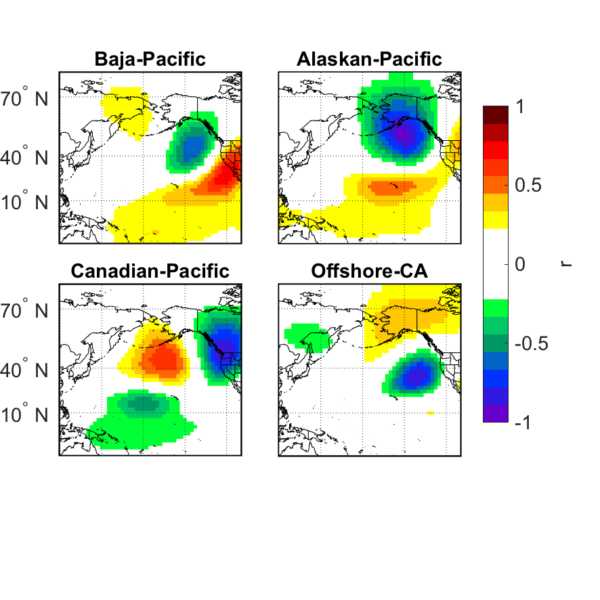Data from: Four Atmospheric Circulation Regimes Over the North Pacific and Their Relationship to California Precipitation on Daily to Seasonal Timescales
Data from: Four Atmospheric Circulation Regimes Over the North Pacific and Their Relationship to California Precipitation on Daily to Seasonal Timescales
About this collection
- Extent
-
1 digital object.
- Cite This Work
-
Guirguis, Kristen; Gershunov, Alexander; DeFlorio, Michael J.; Shulgina, Tamara; Delle Monache, Luca; Subramanian, Aneesh C.; Corringham, Thomas W.; Ralph, F. Martin (2020). Data from: Four Atmospheric Circulation Regimes Over the North Pacific and Their Relationship to California Precipitation on Daily to Seasonal Timescales. UC San Diego Library Digital Collections. https://doi.org/10.6075/J0154FJJ
- Description
-
Abstract: Precipitation in California is highly variable and not well forecasted on subseasonal-to-seasonal (S2S) timescales. Understanding relationships between synoptic-scale atmospheric circulation and hydrometeorological extremes could improve predictability. This work demonstrates the importance of four North Pacific circulation regimes (called the NP4 modes) in modulating precipitation, flooding, and water resources in California. Here we demonstrate how, on daily timescales, interactions between the NP4 modes drive coastal flow that can result in dry conditions from atmospheric ridging or wet conditions associated with enhanced onshore flow and atmospheric river (AR) landfalls. Seasonally, the prevalence of certain NP4 phase relationships can tip the scale towards wet or dry conditions. Relationships between El Niño Southern Oscillation (ENSO) and the NP4 are explored, and we provide insight into the poorly-forecasted Western US seasonal precipitation during the “Godzilla” El Niño winter of 2016 by examining climate-weather linkages in a historical context.
- Scope And Content
-
This dataset contains four indices of daily atmospheric variability associated with four circulation regimes over the North Pacific (Figure 1), which have been identified as essential drivers of atmospheric river landfall variability and California precipitation. The circulation regimes were derived using varimax rotated EOF analysis applied to 500 mb geopotential height (G500) anomalies over a domain spanning the northern Pacific Ocean and the western US. The corresponding principal components (PCs) were obtained by projecting the original G500 data onto each of the rotated EOFs, therefore the resulting PCs describe the historical temporal daily evolution of the four circulation regimes. These patterns are named according to their geographic centers of action as follows: Baja-Pacific (BP), Alaskan-Pacific (AP), Canadian-Pacific (CP), and Offshore-California (OC), which are collectively known as the North Pacific-4 (NP4) modes. The indices provided give the daily amplitude of each PC normalized by the standard deviation of the daily distribution. The dataset covers the most active part of the California precipitation season (November-February) over the 1948-2017 record. The source G500 data are from NCEP/NCAR global Reanalysis (Kalnay et al. 1996). This dataset was derived using established methodology for identifying teleconnection patterns (e.g. Barnston and Livezey, 1987).
- Creation Date
- 2018
- Date Issued
- 2020
- Authors
- Funding
-
US Department of Reclamation: USBR-R15AC00003; California Department of Water Resources: 4600010378 UCOP2-11; National Oceanic and Atmospheric Administration: NA17OAR4310284; Southwest Climate Adaptation Science Center: G18AC00320
- Geographics
- Topics
Formats
View formats within this collection
- Language
- English
- Related Resources
- Guirguis, K., Gershunov, A., DeFlorio, M. J., Shulgina, T., Delle Monache, L., Subramanian, A. C., et al. (2020). Four Atmospheric Circulation Regimes Over the North Pacific and Their Relationship to California Precipitation on Daily to Seasonal Timescales. Geophysical Research Letters, 47, e2020GL087609. https://doi.org/10.1029/2020GL087609
- NOAA NCEP/NCAR Reanalysis 1: Summary: https://psl.noaa.gov/data/gridded/data.ncep.reanalysis.html
- Barnston, A.G. and Livezey, R.E. (1987) Classifications, Seasonality, and Persistence of Low-Frequency Atmospheric Circulation Patterns. Monthly Weather Review, 115, 1083-1126. https://doi.org/10.1175/1520-0493(1987)115<1083:CSAPOL
- Guirguis, K., A. Gershunov, R.E.S. Clemesha, T. Shulgina, A. C. Subramanian, and F.M. Ralph, 2018: Circulation Drivers of Atmospheric Rivers at the North American West Coast. Geophys. Res. Lett. http://doi.org/10.1029/2018GL079249
- Kalnay, E., et al., 1996: The NCEP/NCAR 40-year reanalysis project, Bull. Am. Meteorol. Soc., 77(3), 437–471. https://doi.org/10.1175/1520-0477(1996)077<0437:TNYRP
Primary associated publication
Source data
Reference
 Library Digital Collections
Library Digital Collections
